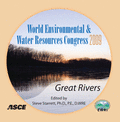Agricultural Drainage Management Systems Task Force (ADMSTF)
Publication: World Environmental and Water Resources Congress 2009: Great Rivers
Abstract
The Agricultural Drainage Management Systems (ADMS) Task Force was initiated during a charter meeting in the fall of 2002 by dedicated professional employees of Federal, State, and Local Government Agencies and Universities. The Agricultural Drainage Management (ADM) Coalition was established in 2003 by drainage industry officials, trade associations and non-government organizations. These two groups formed a working partnership to promote and implement drainage water management systems that can significantly improve the quality of drainage water flows from agricultural cropland. Earlier research had shown that a large percentage of the nitrate-nitrogen that migrates down the Ohio and Mississippi Rivers comes from surface and subsurface drainage discharge from agricultural cropland in the Midwest region. An initial primary goal of the partnership groups was to reduce the loss and transport of fertilizer nutrients, particularly nitrate-nitrogen, from drained agricultural croplands in the Midwestern States on a farm-by-farm basis. They installed and conducted field demonstrations for farmers to promote and encourage them to install and implement drainage water management practices (controlled-drainage) for both new drainage installations and by retrofitting their existing drainage systems with drainage outlet controls. Previous research that had been conducted at multiple locations to evaluate controlled-drainage systems documented that the decrease in nitrate-nitrogen loss in drainage discharge was almost directly proportion to the reduction in drainage outflow volume accomplished by installing control structures on the drainage outlets. A 50% reduction in drainage outflow and nitrate loss was a common research finding at most of these locations. The desired ultimate goal of the ADMSTF and ADMC partnership efforts was to implement drainage water management on a large enough scale (watershed-by-watershed) in the Midwest to decrease transport of excess nutrients through the Mississippi River drainage basin to the Gulf of Mexico. EPA and USGS had reported this source of nitrate-nitrogen as one of the major sources contributing to the persistent formation of the large hypoxic zone ("dead zone") in the Gulf of Mexico.
Get full access to this article
View all available purchase options and get full access to this chapter.
Information & Authors
Information
Published In
Copyright
© 2009 American Society of Civil Engineers.
History
Published online: Apr 26, 2012
ASCE Technical Topics:
- Agriculture
- Business management
- Chemical compounds
- Chemicals
- Chemistry
- Drainage
- Drainage systems
- Engineering fundamentals
- Environmental engineering
- Federal government
- Government
- Irrigation engineering
- Nitrates
- Organizations
- Practice and Profession
- Salts
- Systems engineering
- Systems management
- Water and water resources
- Water management
- Water quality
- Water treatment
Authors
Metrics & Citations
Metrics
Citations
Download citation
If you have the appropriate software installed, you can download article citation data to the citation manager of your choice. Simply select your manager software from the list below and click Download.
